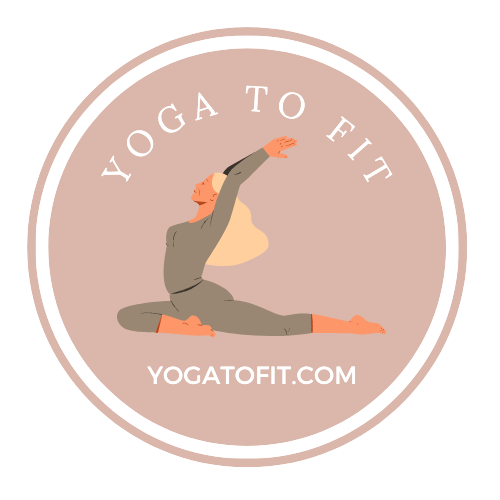Yoga On The Beach – A Complete Guide

Have you ever had a chance to practice yoga on the beach? Well, it is one of the best yoga practices in the relaxing vibe of the beach with the soothing view of the ocean. This whole environment of yoga on the beach results in energizing and positive yoga sessions. Many studies and research have confirmed that spending time near a water body helps in reducing stress and anxiety. Let’s talk about how yoga on the beach helps in achieving good physical as well as mental health, what are the benefits of doing yoga on the beach and what asanas can be performed on the beach.
Benefits of Yoga on the Beach
Practicing yoga on the beach makes your session more exciting and enjoyable. Here are some benefits you may experience while doing yoga on the beach. Have a look:
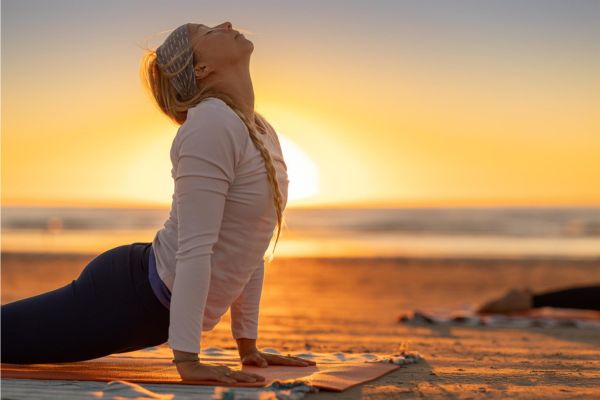
1. Enhance Your Creativity
Practicing yoga outside the walls enhances your mind much more than doing it inside. Your creativity level increases as much as you practice yoga in the fresh air. The parts of your brain that become activated during exercise can help to enhance creativity.
2. Deepen Your Relaxation
If you exercise outside, you will feel more relaxed as compared to exercising indoors. Yoga on the beach strengthens your body and mind through which you feel more relaxed. Being in contact with nature leaves a positive impact on your body and especially on your nervous system. It can also help you cool down after a difficult yoga session.
3. Commune With Nature
Doing yoga on the beach also helps you communicate with nature. Feeling the grass under your toes, the sand in your feet and the fresh air on your skin can all help your body in different ways.
4. Increased Mood Support
In case you want mental benefits and enhance your mood, yoga on the beach is the option. Increased mood support is the greatest benefit of increased mood support for an individual. Practicing yoga outside has much more benefits on your mind as well as body as compared to practicing inside. Heading out to the beach for your yoga class can make you feel even happier.
5. Sand Is A Cushion
Sand has a shock-absorbent feature. In case, you fall down while practicing any difficult pose, sand prevents you from any severe injury. You might even feel like trying out a few more challenging poses. In case you try difficult poses inside on hard surfaces, there are more chances of having muscle or bone injuries.
6. Essential Vitamin D
Lack of vitamin D is linked with various diseases. By practicing Yoga on the beach you get proper sunlight which provides you with essential vitamin D for your body. You can even practice yoga on a cloudy day or in the shade, you can get the essential vitamin D that your body needs to regulate calcium and phosphate in your system and to feel happy and healthy.
Poses for Beach Yoga
Here are some best poses that can be practiced on the beach:
1. Downward Facing Dog (Adho Mukha Svanasana)
This pose is very popular in vinyasa yoga. This pose strengthens your legs and arms as it includes stretching your hamstrings, calves, shoulders, and hands. This pose also helps in dealing with stress.

How to Practice:
- Begin in a tabletop position with your knees stacked directly under your hips and your wrists stacked under your shoulders.
- Exhale while tucking your toes and lifting your knees off the sand.
- Spread your fingers and press your hands down in front of you while straightening your back as much as possible.
- Gently bend your knees, one at a time, working your way into your own version of Downward Facing Dog.
- Bring your gaze towards your feet while aligning your hand with your spine creating a straight line.
- Take a few deep breaths and when you’re ready to exit the pose, gently lower your knees back onto the sand into the tabletop position.
2. Tree Pose (Vrksasana)
Practicing yoga by the ocean provides peacefulness and balance to the body and soul. This pose includes stretching the thighs, core, and shoulders while strengthening the spine, thighs, and calves. You need to focus on your breathing while improving your balance.

How to Practice:
- Begin in Mountain Pose (Tadasana) and inhale while lifting your arms towards the sky.
- Now exhale, bringing your hands by your heart.
- Choose a focal point to provide balance slowly lift your right foot off the sand and place it on your left ankle.
- Take your time, now lift your right foot further until it reaches the side of your left knee.
- Take a few deep breaths here and whenever you’re ready. return to Mountain Pose; repeat this pose on the opposite side.
3. Shoulder Stand (Sarvangasana)
This pose is a little bit difficult to practice on the beach but this relaxes you to the core. Be cautious and attentive while performing this yoga pose. This pose helps in relieving stress and depression, strengthening the glutes, arms, core, legs, and arms as well as improving digestion. The best part of practicing this pose is if you fall down while practicing this pose, the sand will provide you cushioning comfort and you won’t get hurt.
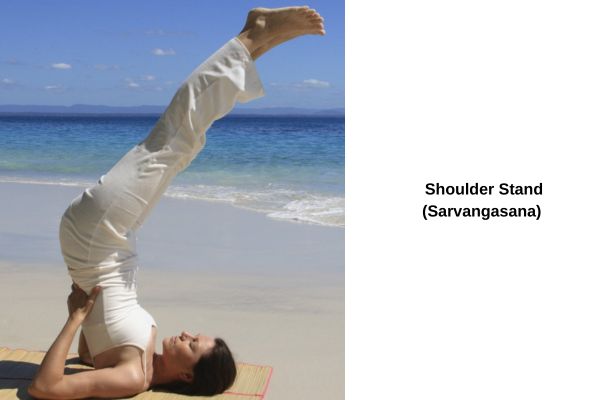
How to Practice:
- Start the pose by laying down on your mat (or the sand) and bring your knees towards your face.
- Now, bring your hands to your hips to support your lower body and lift your hips and legs towards the sky while trying to keep them straight.
- Take a few deep breaths; to exit the pose, slowly lower your hips and legs to the ground.
- You can also choose to stay in a shoulder stand in order to transition to the next posture.
4. Plow Pose (Halasana)
This yoga pose helps reduce back pain and stress, calming the mind, and stretching the spine and shoulders. This is a great pose for the beach because it encourages deep relaxation and stress relief.
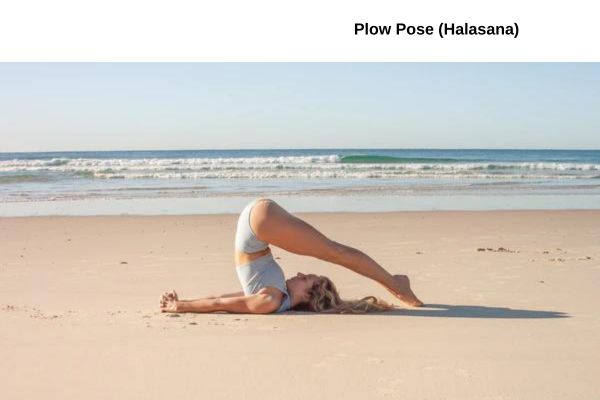
How to Practice:
- Begin the pose in a shoulder stand and slowly bring your extended legs back towards your head until your toes touch the mat behind your head.
- Now, bring your chin away from your sternum and keep your hands on your lower back for additional support, or release them onto the mat and stretch them behind you.
- Hold for a few minutes.
- Now, bring your hands to your lower back again and exhale while slowly lowering your legs down to exit the pose.
5. Bow Pose (Dhanurasana)
The benefits of practicing this yoga pose on the beach are it improves your posture, strengthens the back muscles, and stretches your thighs, core, chest, throat, and hips.
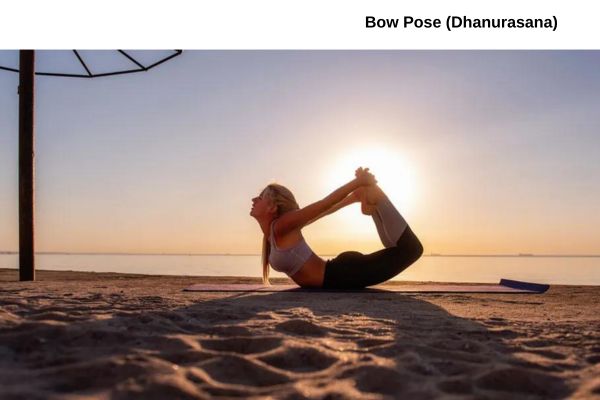
How to Practice:
- Lay on your stomach with your arms extended by your sides with your palms up.
- Now, take a deep exhale and reach for your heels with your hands while bending your knees.
- Hold onto your feet while trying to lift your thighs slightly off the mat and gaze forward.
- Stay in this pose for about 30 seconds and release your legs and arms towards the mat while taking a deep exhale.
6. Pigeon Pose (Kapotasana)
This yoga pose is known as a wonderful pose for lengthening your hip flexors, preparing the body for backbend poses as well as opening the hip joint, and reducing stress and anxiety.
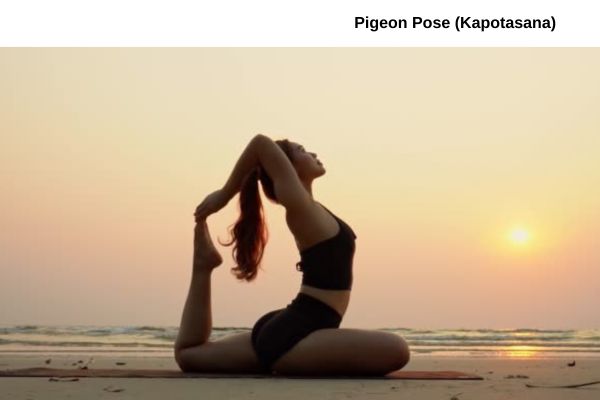
How to Practice:
- Begin the pose in a seated position with your feet tucked under your glutes.
- Now, extend your right leg back on the mat while keeping your left leg bent in front of you.
- Take a deep inhale and as you exhale, release your body onto your front leg and extend your arms on the mat in front of you.
- Also, try to bring your forehand to touch the mat and close your eyes.
- Take a few deep breaths, allowing your body to sink even deeper into the pose with every exhale.
- To exit the asana, slowly walk your hands back up towards your torso and return to a seated position.
7. Easy Pose (Sukhasana)
This pose allows you to take a moment and sit still to breathe after having a tough yoga session. This technique will enhance your yoga practice as well as increase the oxygen in your blood, relieve tension, detoxifies your body and mind as well and help to increase your mind-body awareness.
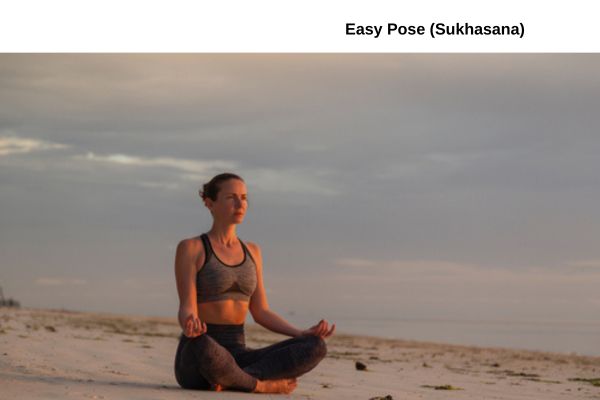
How to Practice:
- Sit comfortably with your legs crossed, your spine straight and your hands in your lap.
- Close your eyes and take several deep breaths, trying to hold your inhale for a few seconds before exhaling.
- Try to eliminate any stressful or negative thoughts while bringing your entire focus to your breath.
You can also attempt the “Ujjayi breath” which is often referred to as the “oceanic breath” and it is used to synchronize your breathing with the asana. The Ujjayi breath consists of breathing through your nose, inhaling deeply, and exhaling slowly through your nose.
- Open your mouth and exhale making a “ha” sound.
- Now, try this with your mouth closed but maintain the intensity of your exhalations.
Read More: Best Moisture-Wicking Yoga Socks
Tips for a Successful Beach Yoga Session
If you want a successful yoga session on the beach without any difficulties or hurdles, you need to follow some tips before and while practicing the session on the beach. These tips will help you guide all the things you need to consider for performing yoga on the beach. Have a look:
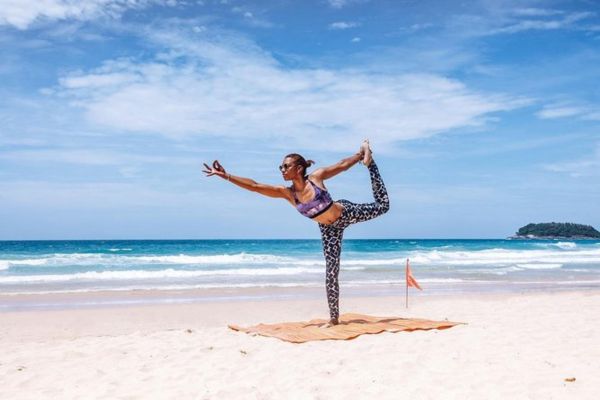
1. Choose the Right Time
The right time to practice yoga on the beach is either in the morning or in the evening. You should avoid the peak hours of harsh sunlight.
2. Use a Beach Towel or Mat
While practicing yoga on the beach, using a beach towel or a yoga mat can improve your session much more. This can provide you with a surface on which you can practice different poses easily by focusing on balance instead of doing it directly on the sand.
3. Sun Protection
Don’t forget to protect yourself from the harsh sunlight. Harmful UV rays can adversely affect your skin. Apply sunscreen all over your body, wear a hat, and wear sunglasses to protect your eyes from those UV rays before going out.
4. Stay Hydrated
In a hot summer climate, you feel more thirsty while practicing yoga on the beach. Don’t forget to take a water bottle with you because you sweat a lot during yoga practice. So, drink plenty of water in between the sessions and keep yourself hydrated.
5. A quick Warm-up
Don’t forget to have a quick warm-up before starting a yoga session on the beach. Warm-up helps you to get ready for the difficult yoga practices. You can take a brief walk alongside the ocean to get familiar with the temperature, the breeze, the color of the ocean, and the life that will surround you on the beach.
Conclusion
Yoga on the beach is a wonderful experience that allows you to connect with nature, enhance relaxation, and improve your practice. The soothing environment of the beach creates a space for you to find inner peace and harmony. Whether you’re an experienced yogi or a beginner, practicing yoga on the beach offers a unique and enriching experience that can renew your body and soul. There are several benefits of practicing yoga on the beach, it enhances your creative mind, deepens the relaxation power, the sand on the beach gives you a cushioning feel, etc.
FAQs
Do I need special equipment for beach yoga?
While you can practice directly on the sand, using a beach towel or yoga mat is recommended for a more stable surface and to create a barrier between you and the sand. Sunscreen, a hat, and sunglasses are also advisable for sun protection.
Can I practice beach yoga alone, or should I join a class?
You can practice beach yoga alone if you’re familiar with the poses and safety considerations. However, joining a class, especially if you’re a beginner, can provide guidance from an instructor and a supportive group setting.
Can I practice beach yoga in any weather?
While beach yoga can be practiced in various weather conditions, it’s advisable to avoid extreme weather situations. Consider the temperature, wind, and any potential hazards. Choose a comfortable and safe environment for your practice.
You may also like:
